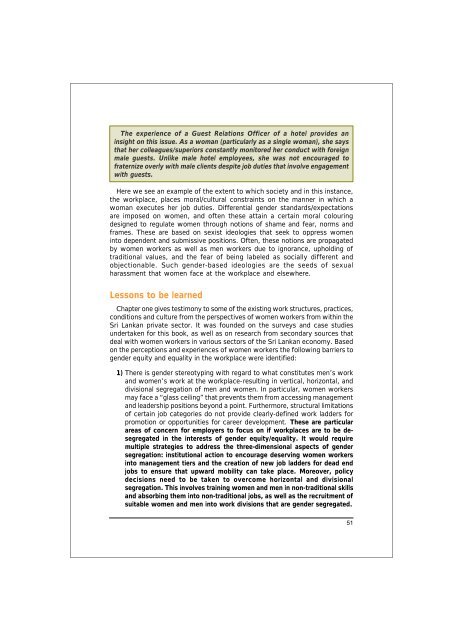Beyond Glass Ceilings and Brick Walls - International Labour ...
Beyond Glass Ceilings and Brick Walls - International Labour ...
Beyond Glass Ceilings and Brick Walls - International Labour ...
Create successful ePaper yourself
Turn your PDF publications into a flip-book with our unique Google optimized e-Paper software.
The experience of a Guest Relations Officer of a hotel provides an<br />
insight on this issue. As a woman (particularly as a single woman), she says<br />
that her colleagues/superiors constantly monitored her conduct with foreign<br />
male guests. Unlike male hotel employees, she was not encouraged to<br />
fraternize overly with male clients despite job duties that involve engagement<br />
with guests.<br />
Here we see an example of the extent to which society <strong>and</strong> in this instance,<br />
the workplace, places moral/cultural constraints on the manner in which a<br />
woman executes her job duties. Differential gender st<strong>and</strong>ards/expectations<br />
are imposed on women, <strong>and</strong> often these attain a certain moral colouring<br />
designed to regulate women through notions of shame <strong>and</strong> fear, norms <strong>and</strong><br />
frames. These are based on sexist ideologies that seek to oppress women<br />
into dependent <strong>and</strong> submissive positions. Often, these notions are propagated<br />
by women workers as well as men workers due to ignorance, upholding of<br />
traditional values, <strong>and</strong> the fear of being labeled as socially different <strong>and</strong><br />
objectionable. Such gender-based ideologies are the seeds of sexual<br />
harassment that women face at the workplace <strong>and</strong> elsewhere.<br />
Lessons to be learned<br />
Chapter one gives testimony to some of the existing work structures, practices,<br />
conditions <strong>and</strong> culture from the perspectives of women workers from within the<br />
Sri Lankan private sector. It was founded on the surveys <strong>and</strong> case studies<br />
undertaken for this book, as well as on research from secondary sources that<br />
deal with women workers in various sectors of the Sri Lankan economy. Based<br />
on the perceptions <strong>and</strong> experiences of women workers the following barriers to<br />
gender equity <strong>and</strong> equality in the workplace were identified:<br />
1) There is gender stereotyping with regard to what constitutes men’s work<br />
<strong>and</strong> women’s work at the workplace-resulting in vertical, horizontal, <strong>and</strong><br />
divisional segregation of men <strong>and</strong> women. In particular, women workers<br />
may face a “glass ceiling” that prevents them from accessing management<br />
<strong>and</strong> leadership positions beyond a point. Furthermore, structural limitations<br />
of certain job categories do not provide clearly-defined work ladders for<br />
promotion or opportunities for career development. These are particular<br />
areas of concern for employers to focus on if workplaces are to be desegregated<br />
in the interests of gender equity/equality. It would require<br />
multiple strategies to address the three-dimensional aspects of gender<br />
segregation: institutional action to encourage deserving women workers<br />
into management tiers <strong>and</strong> the creation of new job ladders for dead end<br />
jobs to ensure that upward mobility can take place. Moreover, policy<br />
decisions need to be taken to overcome horizontal <strong>and</strong> divisional<br />
segregation. This involves training women <strong>and</strong> men in non-traditional skills<br />
<strong>and</strong> absorbing them into non-traditional jobs, as well as the recruitment of<br />
suitable women <strong>and</strong> men into work divisions that are gender segregated.<br />
51
















